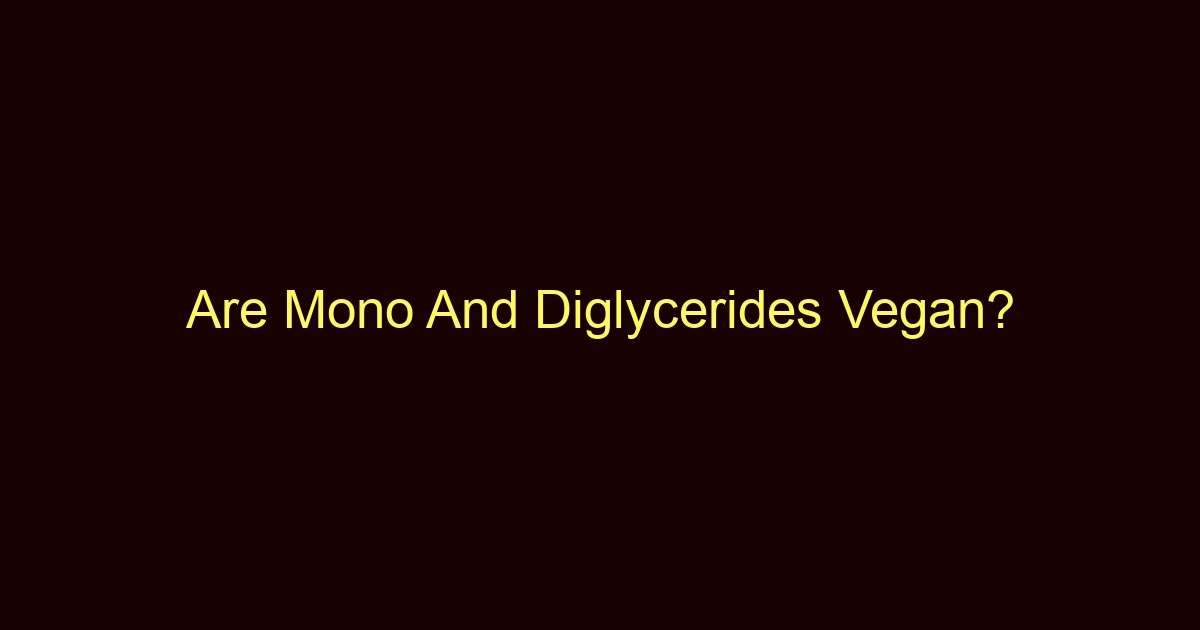Mono and diglycerides are omnipresent food additives that you’ll often find in the ingredients list of numerous processed foods. They serve a crucial role in food science, but as a consumer, you might wonder about their origin and whether they’re suitable for a vegan lifestyle. Let’s dig into the subject.
What are Mono And Diglycerides?
Mono and diglycerides are types of fat that are commonly used as emulsifiers in food products. An emulsifier is an additive that helps mix two substances that would not typically mix well together, such as oil and water. These compounds are formed from the breakdown of fats, either from animal or plant sources, into glycerol and fatty acids. The resultant monoglycerides and diglycerides are less complete fats compared to triglycerides, which is the form of fat we usually consume and store in our bodies.
Their capacity to blend ingredients smoothly is the reason why they’re commonly found in processed foods like baked goods, ice cream, margarine, and even in bread and some dairy products. But how are these compounds produced?
How are Mono And Diglycerides Made?
Mono and diglycerides are created through a process called lipolysis, where triglycerides, the primary form of fat in our diet, are broken down. This process can be performed using either chemical reactions or specific enzymes. The result is a mix of mono and diglycerides, which are then purified and used in food production.
The catch here is that triglycerides used in the production of mono and diglycerides can be sourced from both plants and animals. This makes it challenging to determine the origin of these emulsifiers just by looking at the ingredients list.
What are Mono And Diglycerides Used For?
Mono and diglycerides are primarily used as emulsifiers in food products. They help to blend ingredients that would not normally mix, improving the texture and consistency of the product. They are also used to extend the shelf life of some products, preventing staleness in baked goods, and keeping oils in salad dressings from separating.
What Foods Contain Mono And Diglycerides?
Mono and diglycerides are found in a wide variety of processed foods. They’re used in baked goods like bread and pastries to improve texture and extend shelf life. They’re also found in margarine, spreads, ice cream, whipped cream, and even some packaged pasta. Essentially, if a food product requires a smooth, uniform texture, there’s a good chance it contains mono and diglycerides.
Are Mono And Diglycerides Vegan?
Determining whether mono and diglycerides are vegan can be tricky. While they can be derived from plant sources like soybean, palm, or canola oil, they can also be derived from animal fats. Unfortunately, manufacturers aren’t required to disclose the source on the packaging.
So, while mono and diglycerides themselves are not animal products, the lack of transparency about their origin means we can’t say for sure whether a product containing these ingredients is 100% vegan unless specified by the manufacturer.
Can Vegans Eat Mono And Diglycerides and Why?
Vegans can eat mono and diglycerides that are derived from plant sources. However, the challenge lies in the uncertainty surrounding the source of these ingredients. Since the manufacturer often doesn’t indicate the source, vegans may choose to avoid products containing mono and diglycerides unless the product is explicitly labeled as vegan.
Health Considerations of Mono And Diglycerides
While mono and diglycerides are generally recognized as safe by the FDA, there have been concerns about the health implications of these additives. Some studies have suggested that these emulsifiers may negatively impact gut health and potentially contribute to inflammatory bowel diseases.
Moreover, they often find their way into highly processed, high-fat, and high-sugar foods that are best consumed in moderation. For most people, it’s more about what these additives represent (processed foods) than the additives themselves that should be of concern.
Mono And Diglycerides in a Plant-Based Diet
It’s important to note that while some mono and diglycerides may be plant-derived, their presence often signals a highly processed product. Many plant-based advocates recommend focusing on whole, minimally processed foods for optimal health. Thus, even though an item may technically be “vegan”, it may not align with a wholesome, plant-centric eating pattern.
While it can be challenging to avoid these additives entirely, especially if you consume processed foods, you can prioritize products that are transparent about their ingredients, choose items labeled as “vegan”, or focus on whole foods as much as possible.
Are Mono And Diglycerides Safe?
In general, mono and diglycerides are safe for most people to consume in normal food amounts. They are on the FDA’s Generally Recognized As Safe (GRAS) list. However, as with any food additive, some individuals may experience negative effects, such as gastrointestinal discomfort. If you have a chronic health condition or specific dietary restrictions, you should consult with a healthcare professional for personalized advice.
Final Thoughts
Mono and diglycerides present a gray area in vegan food labeling due to the potential use of animal fats in their production. While they can be derived from plant sources and are not inherently non-vegan, the lack of requirement to specify their origin on food labels can make it challenging for individuals following a strict vegan diet.
Remember, a food’s vegan status does not automatically equal healthiness. Mono and diglycerides are frequently found in heavily processed foods, which should be consumed in moderation. As a general rule, a focus on consuming mostly whole, plant-based foods will provide the most health benefits, regardless of these smaller details.

